Actualizing Net Zero

The Appleton Greene Corporate Training Program (CTP) for Actualizing Net Zero is provided by Mr. Chidwick Certified Learning Provider (CLP). Program Specifications: Monthly cost USD$2,500.00; Monthly Workshops 6 hours; Monthly Support 4 hours; Program Duration 12 months; Program orders subject to ongoing availability.

Personal Profile
Mr. Chidwick comes to Appleton Greene with over 25 years of energy experience in multiple industries and has hands-on experience with developing energy strategies for net zero mitigation and adaption. His engineering background, business involvement, and dedication to the green energy movement inspired him to leverage this wealth of real-world experience to develop the ‘Actualizing NetZero’ program to help other companies create energy plans appropriate for their unique circumstances.
Mr. Chidwick understands the current energy issues facing businesses. For decades, burning fossil fuels provided cheap and abundant energy that brought success to the economy and was perceived as an infinite source of low cost heat and power. Over the past decade, global climate awareness has spawned technical mandates, intertwined with ethical and financial pressures, to reduce energy consumption and carbon footprints. As a result, our economy is transitioning to a lower energy and carbon future, where most organizations are influenced by three objectives: to reduce energy costs, to reduce carbon emissions, and to provide energy security through sustainability.
Mr. Chidwick supports the effective development of your Actualizing Net Zero program, which is tailored to your specific industry and location by engaging with your workforce and data to ensure the strategy is future proof, actionable, and successful.
Mr. Chidwick combines an understanding about businesses and the energy issues facing them with real-life experience creating solutions, and provides a compelling course that adds value to any business arsenal serious about tackling the realization and actualization of affordable netzero energy.
Following a successful career as a management consultant in the energy sector developing strategies to help organizations reduce energy costs, reducing emissions and developing energy security, Mr. Chidwick has developed the ‘Actualizing NetZero’ program. This program brings together first-hand experience working in this rapidly developing industry, understanding the breadth of challenges in different regions and industries, as well as a passion for energy efficiency and carbon management.
To request further information about Mr. Chidwick through Appleton Greene, please Click Here.
(CLP) Programs
Appleton Greene corporate training programs are all process-driven. They are used as vehicles to implement tangible business processes within clients’ organizations, together with training, support and facilitation during the use of these processes. Corporate training programs are therefore implemented over a sustainable period of time, that is to say, between 1 year (incorporating 12 monthly workshops), and 4 years (incorporating 48 monthly workshops). Your program information guide will specify how long each program takes to complete. Each monthly workshop takes 6 hours to implement and can be undertaken either on the client’s premises, an Appleton Greene serviced office, or online via the internet. This enables clients to implement each part of their business process, before moving onto the next stage of the program and enables employees to plan their study time around their current work commitments. The result is far greater program benefit, over a more sustainable period of time and a significantly improved return on investment.
Appleton Greene uses standard and bespoke corporate training programs as vessels to transfer business process improvement knowledge into the heart of our clients’ organizations. Each individual program focuses upon the implementation of a specific business process, which enables clients to easily quantify their return on investment. There are hundreds of established Appleton Greene corporate training products now available to clients within customer services, e-business, finance, globalization, human resources, information technology, legal, management, marketing and production. It does not matter whether a client’s employees are located within one office, or an unlimited number of international offices, we can still bring them together to learn and implement specific business processes collectively. Our approach to global localization enables us to provide clients with a truly international service with that all important personal touch. Appleton Greene corporate training programs can be provided virtually or locally and they are all unique in that they individually focus upon a specific business function. All (CLP) programs are implemented over a sustainable period of time, usually between 1-4 years, incorporating 12-48 monthly workshops and professional support is consistently provided during this time by qualified learning providers and where appropriate, by Accredited Consultants.
Executive summary
Actualizing Net Zero
Background
Pain Points
● Energy Transition
● Energy Cost and Cost Certainty
● Energy Security
● Emissions Reduction and Brand Management
● Energy Systems Modernization and Deferred Maintenance
● Technologies – Where Do I Start?
● Translating to CFO Speak – Investment Grade Energy Strategy
Market Trends
● Electrify Everything
● Micro Grids
● Dispatchable Clean Energy
● Transition to Electric Vehicles
Case Studies
● Hotels
● High Schools
● High Density Residential and Electric Vehicles
Background
The political reality for most countries is oriented toward energy and carbon reduction to address environmental challenges. While industry underpins the economy, it also has a significant influence on the environment that runs counter to our political and environmental commitments. The ‘Actualizing NetZero’ program addresses the needs of industry to play a significant role in attaining our climate change initiatives.
Whether driven by social pressures, or by a need to manage expected increases in energy costs, most organizations are now paying much more attention to their energy consumption and emissions. We expect that the cost for electricity will increase substantially in the decades to come as the grids decarbonize. While affordability is the biggest concern, cost certainty is a key concern for facility operators.
Facility operators are challenged with competing objectives including:
● Energy cost and cost certainty
● Energy security
● Emissions reduction and brand management
● Energy systems modernization and deferred maintenance
● Understanding the technology landscape – Just where do I start?
● Developing an Energy and Carbon Strategy
● Financing projects – Translating the technical plans to “CFO Speak”
● Case Studies: What can we learn from others?
The ‘Actualizing NetZero’ program addresses the global movement toward a more energy sustainable future, and helps businesses develop ways to improve energy efficiency, reduce costs, reduce emissions, and provide energy security for industrial, commercial, and institutional facilities.
The first step in achieving these goals addressed in this ‘Actualizing NetZero Program’ is through an investment grade energy strategy. We will explore what an investment grade energy strategy entails, its key components and the benefits it offers.
Our experience in multiple industries has revealed that the development of these Investment Grade Energy and Carbon Strategies (IGS) has accelerated the investment into energy solutions. In every case, the IGS resulted in a successful project implementation.
The key reason for the success of the IGS is that we translate “techy-speak” into “CFO-speak” by providing analyses and graphics that clarify the value of investment decisions.
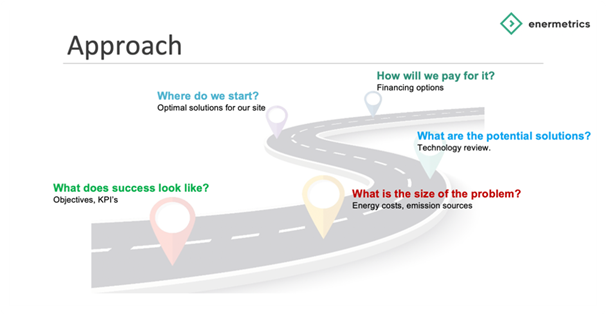
Energy Cost
The cost of energy for a facility is increasing and is presenting challenges for operators. With the energy transition, the cost for heat and electricity is anticipated to increase significantly in the years to come.
Some regions have implemented a carbon tax which puts further pressure on increases in energy cost.
Many regions have legislated reductions in carbon emissions for their electricity grids. Electricity producers need to invest in new technologies to address these new regulations which will result in increases in electricity rates.
Most regions have charges for both the electricity consumed as well as the peak demand. Often each of these are 50% of your costs. Managing the peak demand is just as important as reducing the electricity consumed.
The cost for energy in many industries (hotels, commercial real-estate, institutions and industrial facilities) is often the largest budget item behind labour. As such, there is significant pressure on facility operators to find ways of reducing energy in order to manage the expected growth in costs.
This program addresses this challenge. First, we design solutions to reduce energy consumption. Next, we develop solutions to generate energy on-site at a much cheaper rate.
After establishing the energy and sustainability objectives and key performance indicators (KPI’s), we will do a deep dive into your energy costs and emission sources – identifying areas that are ideal for improvement. This will lead to a review of the core energy systems and processes and how they contribute to the problem.
Data is a critical aspect of the strategy. Detailed and trustable data is crucial to identify the right solutions as well as to provide accurate KPI’s that support the decision-making processes. The program will identify the energy data required, how it is captured (meters, sensors, databases), managed and quality controlled.
An energy audit is a common approach that will identify quick wins for energy conservation. It’s always best to reduce your energy consumption first. ASHRAE defines three levels of energy audits which are progressively more expensive.
Rather, our experiences have found that using the detailed actual energy consumption in a simulation approach to be much more effective, accurate and the results trustable. Utilizing this simulation approach will enable us to consider a wide-range of technologies identifying those that have the best line-of-sight to success.
Energy Security
There are many organizations where energy security is critical and cannot tolerate failures in the electricity grid. Examples include grocery stores that have millions of dollars in spoilable inventory that will be wasted if electricity is not available. Seniors residences have critical equipment the must continue to operate for life-safety. Hospitals and emergency services must be able to operate in the event of a disaster. The hospitality / hotel industry must be able to support their guests.
This program will investigate a wide-range of on-site energy production solutions to address energy security. The development of micro-grids (including solar PV, generators, combined heat and power, batteries, etc.) can provide sufficient energy to continue to support the facility when the grid is not available.
Emissions Reduction and Brand Management
Many organizations have made commitments to reduce atmospheric emissions in order to address pressures from their customers, shareholders and investors.
Access to capital is critical for any organization. But many lenders and investors are now demanding that organizations demonstrate their progress towards energy and sustainability goals.
It is becoming more common that skilled talent will consider the organizations sustainability record before accepting a job.
Balancing investments in emissions reduction with the financial health of the organization is an unenviable challenge for the executive. This program will investigate and identify solutions that not only reduce emissions but are also financially beneficial – addressing this challenge for the executive.
Energy Systems Modernization and Deferred Maintenance
Every facility has a list of aging or degrading energy systems that need to be modernized but do not have sufficient budget to address everything needed. This creates frustration with facility operators that provide heroic efforts to keep these systems functioning.
It’s not uncommon that it’s only when a critical system completely fails that investments are made to modernize. But the costs to limp along before a catastrophic failure are never recovered. At what point does it make financial sense to invest in modernizing aging equipment? This is the challenge faced by every facility operator.
This program provides the analyses and financial business case to address this challenge. The executive don’t want to hear about the technical challenges (which they won’t understand), rather they need this translated into financial and environmental metrics that will support their investment decisions.
This is one of the key deliverables of this program – “to translate techy-speak to CFO-speak”.
Understanding the Solution Landscape – Where Do I Start?
As expected in this energy market transition, new and innovative technologies for energy efficiency and carbon reduction are introduced to the market at a feverish rate. Some of these technologies will survive the journey from innovation, to early majority to market adoption. However, as we are early in this market transition, it is not yet clear just where to make a bet – leading to the question “Just where should I start?”.
Some of these solutions are simply ineffective, some have potential and others have some market traction. The challenge for facility owners is to find a way to sift through the noise and develop a plan that will be effective given their unique needs and constraints.
As new technologies enter the market, they move across the Cost-Maturity quadrant. Starting in the “Innovation” (high cost / low maturity) quadrant, technologies are incubated and attract early adopters. As they technologies “mature” and gain some market adoption with the early majority, they move along the maturity axis but often do not reduce their cost. Finally as technologies find market success, they become a “commodity” and the costs come down.
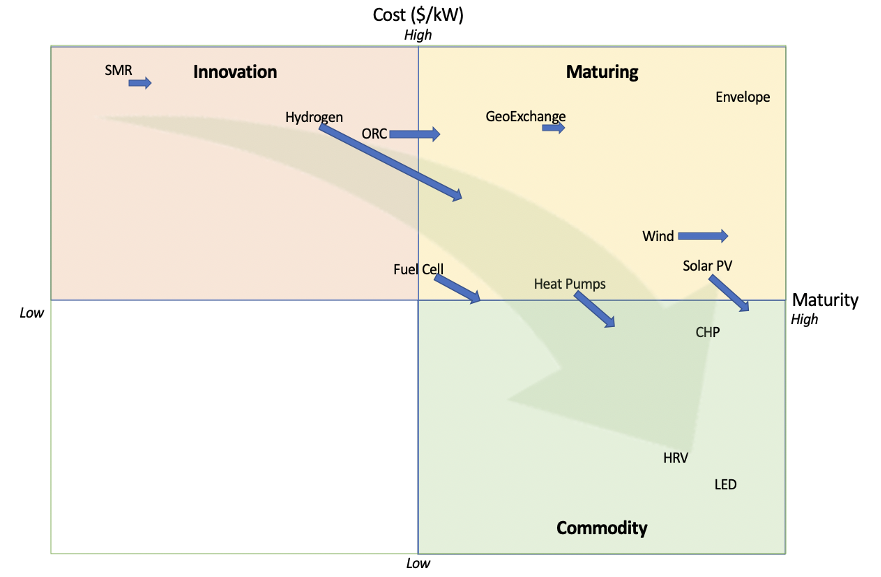
Understanding the scope of solution options and how they align with the needs of your facility is a core part in developing your energy and sustainability strategy.
Supporting organizations of all sizes in a range of industries including government, high density residential, hotels and hospitality, commercial real-estate and industrial facilities, this program has developed a range of services, tools and analyses to harden the development of an energy and sustainability strategy.
Developing an Energy and Carbon Strategy
The ‘Actualizing NetZero’ program addresses the global movement toward a more energy sustainable future, and helps businesses develop ways to improve energy efficiency, reduce costs, reduce emissions, and provide energy security for industrial, commercial, and institutional facilities.
The first step in achieving these goals is through an investment grade energy strategy (IGS). In this program, we will explore what an IGS entails, its key components and the benefits it offers.
Our experience in multiple industries has revealed that the development of these IGS has accelerated the investment into energy solutions. In every case, the IGS resulted in a successful project implementation.
The key reason for the success of the IGS is that we translate “techy-speak” into “CFO-speak” by providing analyses and graphics that clarify the value of investment decisions.

Case Study: Hotels
Hotels have certainly had a tough pandemic. As a result, hotels are seeking to reduce operating costs.
We completed a study of 2101 hotels across all 50 states to identify energy solutions that focus specifically on cost reduction. The electricity and natural gas data for each hotel was normalized for hotel size and organized by state and climate zone. The normalized data was aggregated to create a hotel architype for each state.
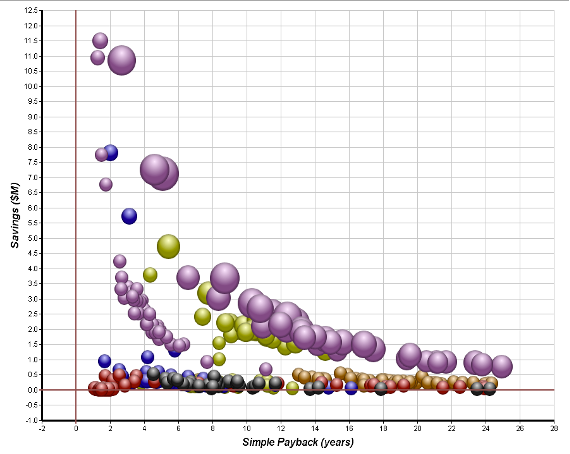
Using energy simulation, we examined the financial and environmental value of a range of technologies including solar PV, solar thermal, CHP, fuel cells, heat pumps and others. Simulating 10 different technologies for each of the architypes in 50 states results in 500 scenarios.
The simulation results are shown in these bubble charts. Each bubble represents a project recommendation (technology for a specific hotel). The colour represents the technology, the size represents the capital cost of the project.
These bubble charts allow us to quickly compare various technologies at specific facilities to each other and identify those that have the best financial and environmental performance.
We were able to demonstrate that solar PV (yellow) did not provide good financial returns. Heat pumps worked well in warmer climates. Hotels with higher thermal demand (e.g. with pools) did very well with combined heat and power (small purple). The conclusion is that there is no single solution that works in every case. Your strategy needs to consider the unique circumstances for your facility.

Case Study: High Schools
We conducted a study on 5671 high schools across the USA to determine which technologies are best to reduce energy costs and emissions. The results are presented in these bubble charts which clearly identify the best scenarios.
Each bubble represents a scenario (a set of technologies for a school). When comparing the simple payback to the cost savings, it is clear that scenarios 99 and 111 have the best savings. These are CHP (natural gas) in California and Hawaii respectively – where the electricity rates are very high.

However, when we look at GHG savings vs NPV, scenario 99 (California) shows a very poor response – because the California grid is relatively clean and there is limited use for waste heat in the summer. Scenario 111 (Hawaii) has reasonable GHG savings as the their grid is relatively dirty.
In most cases, solar PV (yellow bubbles) out performs CHP (small purple bubbles). This is due to the operating schedule of schools (and the need for electricity) aligns well with the solar generation potential. Further, there is limited need for CHP heat in states with warmer weather.
Fuel cells (blue) have the lowest financial performance as the cost of hydrogen is still too high. Further, the availability of hydrogen is still a challenge.
Upgrading heating systems with high efficiency condensing boilers (red bubbles) has a very short simple payback but does not have material cost savings.
There are many factors to consider when designing your energy cost and emissions reduction strategy. You need to consider the cost of energy, grid carbon emissions, transmission and delivery costs, and many other factors.
It gets complex. But through this program, we are able to clearly identify which scenarios will best align with your objectives.

Case Study: Electric Vehicles
The collision of two major market transitions (shift to electric vehicles (EV’s) and shift to densification of housing) has created concern that the electricity grid will be able to provide the energy required. Combining onsite generation with intelligent energy management has the ability to address this issue.
One of the biggest challenges for EV charging in high density residential buildings is the peak power demand. In a residential complex, the cars tend to plug-in to chargers when the electricity demand is at its highest – around 5-8pm. Without building integrated intelligent power management, a large number of EV chargers will dramatically increase the peak demand for the grid.
By combining onsite dispatchable power generation in combination with intelligent building integrated EV chargers can support a large number of EV’s while minimizing the demand on the grid and lowering the costs to tenants.

Case Study: Micro Grids
The development of micro-grids is a successful approach to reducing energy costs, emissions and provides energy security. A micro-grid incorporates a variety of energy sources such as solar, combined heat and power and geothermal with energy storage such as electricity batteries and thermal storage.
A microgrid’s main purpose usually is to improve resiliency. Many businesses cannot tolerate grid failures. Hotels and hospitality must provide the expected services for their guests. Grocery stores must be able to keep their inventory from spoiling. Hospitals and emergency shelters must be able to provide for the needs of people in emergencies.
Market Trends
Dispatchable Clean Energy
There is much interest in “dispatchable” clean energy. Renewables such as solar PV and wind are non-dispatchable – meaning power is produced when the sun is shining and the wind is blowing and you cannot control when you get the power.
Batteries help to capture excess electricity from renewables to address this issue. The cost for batteries has been rapidly decreasing and will eventually become much more economic. Batteries will help transition the non-dispatchable renewables into a dispatchable resource.
Geothermal energy is both renewable and dispatchable – meaning you can control when the power is produced. These technologies are only now emerging in the “innovation” quadrant but have good potential to transition to commercial scale operations.
Natural gas continues to be the most cost effective dispatchable electricity source. A number of significant advancements in the capture of carbon emissions from fossil fuel sources have been making big strides. These technologies make it possible to separate the carbon from a methane stream leaving hydrogen and carbon black (a powder) resulting in no atmospheric emissions. This allows natural gas rich regions (Alberta, central USA) to continue to utilize their natural resource without any atmospheric emissions.
Electrify Everything?
Popular belief is that we need to electrify everything from heating to transportation. However, there are practicalities that make this challenging in different regions. Can our local grid provide the power we need to electrify our business? And at what cost?
The right answer needs to consider a more balanced approach between our environmental goals and financial realities.
Every region has its energy advantages – from solar PV, to hydro, to geothermal, to natural gas. The balance comes when we can leverage these advantages to design a solution that aligns with the corporate objectives.
Decarbonize the Grid
Most municipal and state governments have set goals to decarbonize their grids in order to encourage the transition to electrifying industry.
Nuclear power – especially micro-modular reactors and small-modular reactors – has the potential to help the transition from fossil fuel base power to clean carbon free base power on our grids. Nuclear is clean from a carbon perspective, but is based on a non-renewable fuel source. The life-cycle cost analysis (total cost per kWh) for nuclear powered heat and electricity is approaching fossil fuel rates – and is anticipated to provide a component of our carbon free energy in the decades to come.
Solar and Wind – the intermittency of traditional renewables makes it challenging for a grid to depend on these non-dispatchable resources. As the cost of electricity storage continues to drop, batteries may provide a solution. But this is still a long way from being cost effective.
Hydrogen holds the promise for a clean fuel capable of dispatchable generation. However, the cost for hydrogen is still far too high to make this economic. The energy required to create the hydrogen (pyrolysis, electrolysis or plasmatics) makes the round trip efficiency quite low. Studies have shown that the cost of hydrogen needs to drop below $1/kg before it is economic.
The drive to decarbonize the grid and electrify everything from heating to transportation continues to be supported by most governments. There are certainly many challenges yet to overcome on the transmission and distribution system.
Curriculum
Actualizing Net Zero – Part 1 – Year 1
- Part 1 Month 1 Energy Objectives & KPI’s
- Part 1 Month 2 Problem: Energy Costs & Information Management
- Part 1 Month 3 Problem: Energy Consumption & Emissions Sources
- Part 1 Month 4 Solutions: Technology Solutions
- Part 1 Month 5 Solutions: Micro Grids
- Part 1 Month 6 Establishing the Baseline
- Part 1 Month 7 Energy and Carbon Strategies
- Part 1 Month 8 Identifying Solutions
- Part 1 Month 9 Implementation Plan
- Part 1 Month 10 Building the Ecosystem & Partners
- Part 1 Month 11 Financing Options
- Part 1 Month 12 Tracking Value
Program Objectives
The following list represents the Key Program Objectives (KPO) for the Appleton Greene Actualizing Net Zero corporate training program.
Actualizing Net Zero – Part 1 – Year 1
- Part 1 Month 1 Objectives & KPI’s – In this module, we will review the structure of the program, the resources needed and expected deliverables.As the world moves towards a more energy sustainable future, we are constantly seeking ways to improve energy efficiency and reduce costs and emissions for our commercial and institutional facilities. The first step in achieving these goals is through an investment grade energy strategy. In this program, we will explore what an investment grade energy strategy entails, its key components and the benefits it offers.Strategies are developed by the executive and implemented by management and staff. We will explore the process changes required for corporate and shareholder reporting as well as the process changes for management and staff to support the strategy.In the first workshop, we will establish the objectives for an energy and carbon emissions solution. What is motivating the development of an energy and carbon strategy? We will review the spectrum of objectives for different markets and locations to trigger thought leadership. We will review case studies and outcomes.We will identify the key performance indicators (KPI’s) that will measure success against these objectives. We will determine what data is required to support the KPI’s, identify any data gaps and develop a plan to address the data issues. Data is critical to the following workshops.We will explore the financial, environmental and logistical constraints that will guide the selection of the right technologies. We will also outline the resources, skills and processes that will be required to execute the plan. These resources will constitute the core team.
- Part 1 Month 2 Understanding Costs – In this module, we will develop an understanding of the scope of the energy and carbon problem. We will investigate the current energy costs and develop and understanding of the key issues that impact energy costs.We will review the current energy costs and identify those areas that have the highest potential for improvement. The first step in reducing costs and emissions is to improve energy cost efficiency. Changing operational processes to operate the facility more efficiently is often the easiest first step.We will identify the risks and constraints for energy systems. Each location has energy advantages as well as constraints that will limit solution options. We will develop an understanding of the regional energy advantages and explore case studies where these advantages have been successful.
- Part 1 Month 3 Energy Consumption and Emissions Sources – In this workshop, we will develop an understanding of the scope of the energy and carbon problem. We will investigate the energy consumers and emission sources and develop and understanding of the key issues that impact costs and emissions.We will develop an inventory of energy systems and identify those areas that have the highest potential for emissions improvement. Operating the facility efficiently is an ongoing effort in process improvement. There are always systems that can be optimized to reduce energy consumption. Often facilities managers don’t have the time or are not focusing attention on the right areas.We will identify potential systems for optimization and the data required to determine how to optimize the key systems.
- Part 1 Month 4 Technology Options – Each region has its own energy advantages (hydro, solar, wind, natural gas) that can be leveraged to reducing costs and emissions. We will review the spectrum of technologies on the market, their maturity, risks and benefits. This workshop will discuss the process challenges to migrate from existing systems to more modern solutions – and may identify technologies that are just not realistic.The workshop will identify realistic technologies and the change management challenges that will be required to implement each of them. These workshops will make it very clear to the project sponsor which projects best align with the corporate objectives, the risk profiles and the resources required to implement.
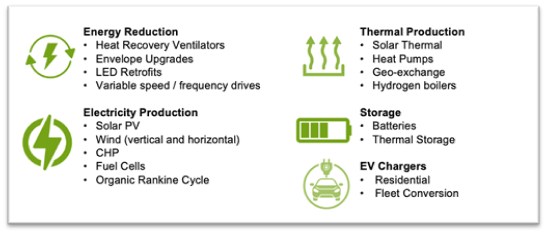
- Part 1 Month 5 Micro Grids – The most commonly used definition of a microgrid is that from DOE as “a group of interconnected loads and distributed energy resources within clearly defined electrical boundaries that acts as a single controllable entity with respect to the grid”.A microgrid can connect and disconnect from the grid to enable it to operate in both grid-connected and island-mode.
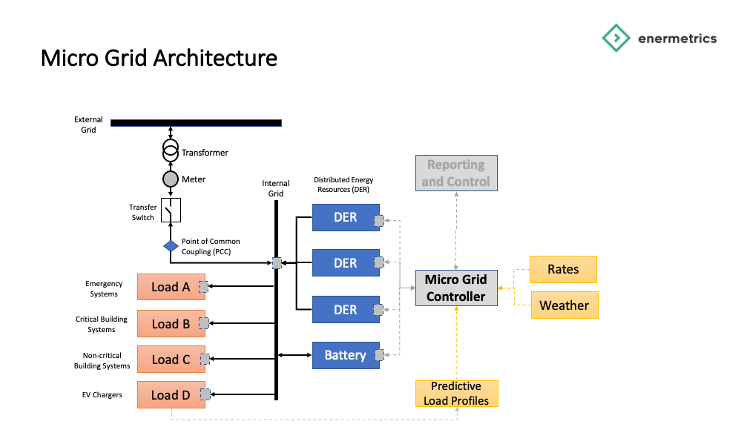
Microgrids are composed of distributed energy resources (DERs) that can provide independent power to designated critical loads upon loss of the primary source of energy. The key business driver for a micro-grid are those facilities that cannot tolerate outages in the electricity grid. For example, grocery stores have a large financial investment in spoilable inventory. Hospitals and seniors residences have life safety equipment that must be kept operational. Hotel / resorts must be able to support the expectations of their guests. This workshop will explore the different types of advance micro-grids and how they operate. - Part 1 Month 6 Baseline and Information Management – With the data properly managed, this module will establish a baseline for energy and emissions. This baseline will be used by the KPI’s to measure progress against the objectives. The KPI’s will be surfaced in the corporate dashboard demonstrating the current state and the objectives / targets. This will require involvement with the IT team.This workshop will discuss the processes and responsibilities of management and staff to ensure that the information surfaced in the KPI’s is current and accurate and achieves trust in those that consume the KPI’s.We will discuss who will be consuming the KPI’s, what the KPI’s are telling us and how the stories can be communicated. KPI consumers (normally executive) will need to integrate monitoring these KPI’s into their activities and provide insights and feedback to the management team.We will discuss how these KPI’s will be consumed and utilized in corporate and shareholder reporting. This workshop will develop an understanding of the data we need to support the KPI’s as well as the processes to optimize the operations, where this data is generated and where it will be managed. This will outline the data gaps, systems required to collect the data, processes and governance to manage the data and will result in the development of an Information Management project plan. It is critical that we have complete, current and correct data in order to identify the right energy and emissions technology plan.We will introduce the requirements for a System of Record, develop the role of the Data Custodian including the processes, governance and tools.The Information Management plan will outline the roles and processes required and identify the resources within the organization. We will explore the advantages of outsources or cloud based information management solutions.
- Part 1 Month 7 Energy and Carbon Strategies – In this workshop, we will explore the structure and content of an Investment Grade Energy and Carbon Strategy. This will include energy efficiency and reduction solutions, energy production solutions, risk analyses and financing options.We will identify the need for an executive sponsor/role for Energy and Carbon leadership, its responsibilities and deliverables.We will discuss how management and staff will provide the executive sponsor with the information required to meet these responsibilities. How often is the data required? How will the data be quality controlled to meet these needs.
- Part 1 Month 8 Identifying the Optimal Solutions – This workshop will review the results of simulating a wide-range of technology options and will make it very clear to the project sponsor which projects best align with the corporate objectives, the risk profiles and the resources required to implement.This will result in the selection of technologies for the organization.Facilities management will identify the effort required and risks to implement these technologies.
- Part 1 Month 9 Implementation Plan – After identifying the optimal technologies in workshop 8, we will develop an implementation plan which will consider supply chain issues, schedules, budgets and resources.This workshop will require a site tour to inform the implementation plan. We will identify challenges for facilities operations and change management (if applicable).We will identify key partners for the technologies to be implemented including the technology providers, utilities, regulators, and especially facilities operations.
- Part 1 Month 10 Building an Ecosystem with your Partners – Successful implementation of the project will depend on solid collaboration with all stakeholders in the project. This will include external resources such as technology providers, utilities, regulators, politics – as well as internal stakeholders such as facilities operations, maintenance staff, IT systems, data managers.Achieving buy-in from all stakeholders will drive a successful implementation.

- Part 1 Month 11 Financing Options – How are we going to pay for it? – This workshop will investigate a range of financing options including self-financing, green loans, performance contracts and micro-utilities.
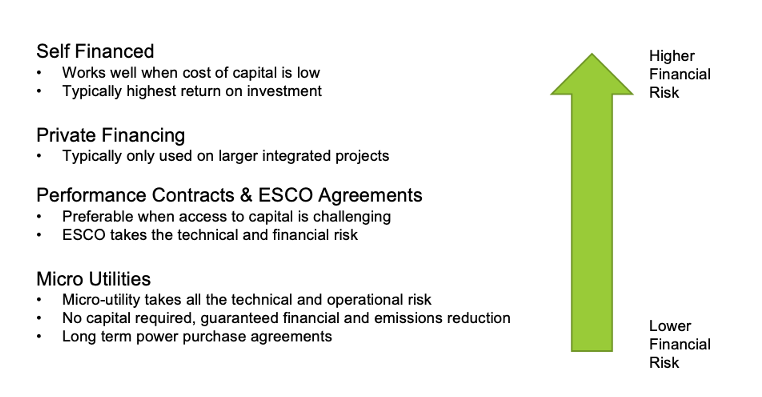
Each model has its own advantages and disadvantages. We will explore the impact on the financial metrics for the selected energy solution. - Part 1 Month 12 Tracking Value – Did we get the value promised? – In this workshop, we will review the KPI’s to determine if the implemented solution is delivering the value expected.We will explore we operational processes might impact the performance of the solution.We will discuss how we can “tell the story” and publish the successes. This will consider articles, social media posts, conferences and political talking points.
Methodology
Actualizing Net Zero
The 12 workshops are structured to build towards a comprehensive Energy and Carbon solution.
The ‘Actualizing NetZero’ program will develop the processes, governance and tools required to develop a strategy for energy and carbon emissions.
As the world moves towards a more energy sustainable future, we are constantly seeking ways to improve energy efficiency and reduce costs for our commercial and institutional facilities. The first step in achieving these goals is through an investment grade energy strategy. In this program, we will explore what an investment grade energy strategy entails, its key components and the benefits it offers.
An investment grade energy strategy is a comprehensive assessment of a facility’s energy usage and potential areas for improvement. Unlike a basic energy audit, an investment grade strategy goes beyond surface-level evaluations and provides in-depth analysis and actionable recommendations. This type of strategy serves as a foundation for making informed decisions regarding energy efficiency measures and on-site energy generation initiatives.
The strategy will result in:
● Improved Energy Efficiency: Identifying energy inefficiencies and implementing recommended measures can lead to significant energy and cost savings over the long term. It’s always best to reduce the energy you need before implementing energy generation solutions.
● Enhanced Sustainability: By reducing energy consumption and carbon footprint, organizations can contribute to environmental stewardship and meet sustainability goals.
● Operational Optimization: provide insights into optimizing building systems, improving occupant comfort, and prolonging the lifespan of equipment.
● Increased Asset Value: Energy-efficient buildings are highly valued in the market, attracting tenants, investors, and potential buyers.
● Access to Incentives and Financing: helps uncover eligibility for government incentives, grants, and financing options for energy efficiency projects.
Industries
This service is primarily available to the following industry sectors:

Education / Institutional Facilities
Developing a comprehensive energy and carbon strategy is crucial for institutions for several reasons, encompassing environmental, economic, and social considerations.
Environmental Responsibility:
Climate Change Mitigation: Institutions contribute to greenhouse gas emissions through their operations. Developing a carbon strategy helps reduce these emissions, contributing to global efforts to mitigate climate change.
Resource Conservation: Efficient energy use and sustainable practices reduce overall resource consumption, helping to protect ecosystems and biodiversity
Economic Efficiency
Cost Reduction: Implementing energy-efficient technologies and practices can lead to significant cost savings over time. Investments in renewable energy sources may initially have upfront costs but can yield long-term financial benefits
Regulatory Compliance: Governments and regulatory bodies are increasingly implementing measures to curb carbon emissions. Having a strategy in place ensures compliance with existing and future regulations, avoiding potential penalties
Reputation and Stakeholder Relations
Public Perception: Institutions that demonstrate commitment to sustainability and responsible environmental practices often enjoy a positive public image. This can attract environmentally conscious stakeholders, customers, and partners
Stakeholder Expectations: Shareholders, customers, and employees are increasingly concerned about environmental issues. Having a robust energy and carbon strategy aligns with stakeholder expectations.
Risk Management
Supply Chain Risks: Institutions may face risks related to the availability and cost of energy resources. Diversifying energy sources and improving efficiency can mitigate these risks
Transition Risks: As the global economy shifts towards sustainability, institutions not adapting may face risks associated with changes in regulations, market dynamics, and technological advancements.
Innovation and Competitive Advantage
Technological Innovation: Embracing clean energy technologies and sustainable practices can foster innovation within an institution. This innovation can lead to a competitive edge in the market.
Attracting Talent: A commitment to sustainability can make an institution more attractive to skilled and environmentally conscious employees.
Long-Term Resilience
Future-Proofing: Developing a strategy that considers future energy trends and potential carbon pricing mechanisms ensures the institution’s resilience in a changing economic and environmental landscape
Measuring and Reporting
Metrics and Reporting: Establishing clear metrics and reporting mechanisms allows institutions to track progress, demonstrate accountability, and communicate achievements to stakeholders.
Collaboration and Partnerships
Industry Collaboration: Institutions can collaborate with other organizations, industry bodies, and government agencies to share best practices, knowledge, and resources in developing and implementing energy and carbon strategies.
Hotels and Hospitality
Hotels have certainly had a tough time with the pandemic. Post pandemic, hotels are now seeking to reduce operating costs.
The energy needs of hotels and resorts are significant, and various business drivers motivate them to manage and optimize their energy consumption. Here are some key business drivers for energy in hotels and resorts
Cost Reduction>
Operational Expenses: Energy costs can constitute a substantial portion of a hotel or resort’s operational expenses, often the largest cost behind labour. Implementing energy-efficient practices and technologies can lead to cost savings in the long run
Competitive Advantage
Resorts that can claim that they are greener enjoy a 57% increase in bookings according to a number of resort owners.
Guests are becoming increasingly environmentally conscious, and hotels that emphasize sustainability and energy efficiency can differentiate themselves in the market.
Guest Satisfaction and Experience
Enhanced Comfort: Energy-efficient technologies, such as smart thermostats and lighting controls, can contribute to a more comfortable and enjoyable guest experience.
Environmental Responsibility: Guests often appreciate and choose hotels that demonstrate a commitment to environmental responsibility. Energy-efficient practices align with the growing demand for eco-friendly accommodation options
Regulatory Compliance
Environmental Regulations: Compliance with local and international environmental regulations is crucial for the hospitality industry. Adhering to energy efficiency standards helps hotels avoid penalties and legal issues
Risk Mitigation
Energy Price Volatility: The hospitality industry is sensitive to fluctuations in energy prices. Implementing energy management strategies can help mitigate the impact of price volatility and ensure more stable operating costs
Long-Term Sustainability
Resource Conservation: Hotels and resorts often operate in scenic or ecologically sensitive locations. Adopting sustainable energy practices contributes to the preservation of these environments, ensuring long-term sustainability for both the business and the surrounding community.
Investor and Stakeholder Expectations
Financial Performance: Investors and stakeholders increasingly consider environmental and social factors when evaluating the performance of a business. Meeting or exceeding energy efficiency goals can positively influence financial performance and shareholder value
Energy Security
In order to provide the services expected by their guests, hotels are sensitive to grid failures. There is a growing interest in developing micro-grids so that they can continue to operate in the event of electricity outages.

Commercial Real-Estate
In the commercial real estate sector, energy efficiency and sustainability have become increasingly important due to a combination of economic, environmental, and social factors.
Commercial real-estate struggles with split incentives. One the one hand, facility owners would like to invest in energy and emissions savings projects, but these would benefit the tenants who pay for their own energy. Tenants in commercial real-estate are often able to move to a new location given the right incentives – such as lower costs and lower emissions. In recent years, larger more stable tenants have expressed interest in reducing their energy and emissions profiles in accordance with their energy and sustainability goals.
As a result, it is difficult to create a business case for investment in energy and emissions reduction projects.
The development of commercial parks is gaining traction. A developer can attract high quality and long term tenants if they can provide low cost / low emissions heat and power with on-site generation, district thermal loops and a micro-grid. Not only does this reduce costs, these commercial parks also provide energy security – critical for many businesses.
Here are some key energy business drivers for commercial real estate:
Cost Reduction
Energy costs can represent a significant portion of a commercial property’s operating expenses. Implementing energy-efficient measures and technologies helps in reducing utility bills and improving overall cost efficiency. On-site energy production in large indoor malls have demonstrated significant energy cost savings.
Energy Security
Buildings that can provide energy security (availability of power in the event of a grid failure) are more attractive to tenants that depend on the space for their businesses. The ability to provide heat and power during a weather event is attractive.
Market Competitiveness and Tenant Retention
Energy-efficient buildings are often more attractive to tenants who seek to reduce their own operational costs and align with sustainability goals. This can lead to higher occupancy rates and quality tenant retention.
Enhanced Asset Value
Energy-efficient buildings often command higher resale values. The value of a building is related to the asset class and the net operating income. If a building can provide low cost energy for the tenants and therefore can command higher rent, the net operating income increases. Investors and owners recognize the long-term value and potential for increased return on investment associated with sustainable properties.
Regulatory Compliance and Owners Goals
The owners of commercial real-estate facilities (often real-estate investment trusts, pension funds, investment portfolios) are under pressure from their investors to demonstrate emissions reduction. These pressures are passed down to the facility operators who need to demonstrate their strategy to reduce emissions.

Industrial
Industrial facilities depend on energy for operations. Industrial and manufacturing businesses are unique in that once established, it is difficult for them to move to a new location. As such, they are motivated to work with the facility owner to invest in energy and emissions reduction projects – unlike commercial real-estate.
Industrial facilities are often large and complex, resulting in greater complexity in developing on-site energy systems. However, the business case for energy projects are often very compelling as power failures can be damaging and costly for operations.
Some of the key business drivers are:
Energy Security
Buildings that provide energy security are more attractive to tenants that depend on the space for their businesses. The ability to provide heat and power during a weather event is attractive.
Cost Reduction
Energy costs can represent a significant portion of an industries operating expenses. Implementing energy-efficient measures and technologies helps in reducing utility bills and improving overall cost efficiency
Regulatory Compliance
Environmental Regulations: Compliance with local and international environmental regulations is crucial for industry. Adhering to energy efficiency standards helps organizations avoid penalties and legal issues
Locations
This service is primarily available within the following locations:

Canada – Alberta
Alberta is unique within Canada as it has a de-regulated energy sector as well as high emissions factors in the electricity grid. As such, Alberta has challenges and benefits compared to the rest of Canada.
Alberta’s economy is largely based on the oil and gas industry accounting for over 20% of the GDP. Commercial real-estate has the second largest contribution to the GDP at 11%. Despite popular belief, agriculture contributes less than 2% of Alberta’s economy. Together, oil and gas, commercial real-estate, construction and manufacturing contribute approximately 50% towards Alberta’s GDP.
The oil and gas industry is supported with talented engineers that are focused on the challenges for hydrocarbon extraction. Oil companies will own and operate electricity generating plants that provide the grid with much of its power.
Alberta has a rich natural gas resource that provides the bulk of the input energy for the electricity grid. In addition, Alberta has abundant wind and solar resource potential. Politically, Alberta is very defensive about external interference that would impact the industry and provincial revenues. The Alberta government is actively supporting projects that seek to leverage the natural gas resource for heat and power generation.
Natural gas combined heat and power (CHP) solutions implemented at facilities as a distributed energy resource have proven to be very effective from both a financial and environmental point of view. By generating the heat and power onsite, the overall efficiencies of the system are much improved. This aligns well with Alberta’s second largest economic contributor – commercial real-estate.
Large office buildings, malls, manufacturing, hospitals, grocery stores, big box stores and seniors residences are all examples of facilities that have been successful in implementing energy technologies to reduce energy costs, reduce emissions and/or provide energy security for their tenants.
Although not a large direct contributor to the Alberta economy, tourism and resorts are often cited as attractors for other sectors to move to Alberta. However, ski resorts, for example, struggle with the impacts of climate change and increasingly need to manufacture snow – which is energy intensive and seasonal. In a recent study, the electricity demand charges that resulted from snow making was the most significant cost after labour.
Resorts and the hospitality sector in general are seeking ways to reduce energy costs and to provide energy security in order to service their guests.
The political environment in Alberta is very focused on protecting the key oil and gas industry. However, there is also a recognition that the environment is a concern. As such, projects that can demonstrate that they utilize the natural gas resource while “also” eliminating atmospheric emissions are the future for Alberta. Technologies are emerging into the market that demonstrate these capabilities.
As Alberta’s electricity grid is deregulated, the electricity rates vary hour by hour and can fluctuate between zero and $1000/MWh. This wide-range of electricity costs make it challenging to manage energy budgets for the large energy consumers such as manufacturing, post-secondary institutions and commercial real-estate. By generating electricity on-site, these fluctuations can leveraged by selling excess electricity to the grid during peak periods.

USA – New York City, NY
Most of the rest of North America operate with a regulated and government owned energy sector. As such, there are additional constraints that need to be considered in the Energy and Sustainability strategy. Many regions have a clean electricity grid so that electrifying a facility can bring down emissions. However, electricity rates can be higher – so a balance is required.
The second largest contributor to the GDP in the USA (behind professional services) is commercial real-estate at 12%. This is followed by manufacturing at 11% and educational services at 9%.
Large office buildings, malls, manufacturing, hospitals, grocery stores, big box stores and seniors residences are all examples of commercial real-estate facilities that have been successful in implementing energy technologies to reduce energy costs, reduce emissions and/or provide energy security for their tenants.
Electricity rates in some states are very high. Hawaii is the most expensive as expected at $0.45/kWh. Rhode Island is only slightly cheaper at $0.32/kWh. The rates in Maine are $0.29/kWh.
Developing energy solutions for the manufacturing sector is more complex as the facilities are much more energy intensive and complex. However, there are a plethora of examples where facilities in the manufacturing sector have been able to significantly reduce their energy consumption and emissions.
Even against political pressures, most states in the USA have moved forward with legislation to reduce carbon emissions. Utilities and state governments have implemented incentive programs to encourage the deployment of carbon saving energy projects.
Each region has their own energy advantages – including solar, wind, geothermal, nuclear. These need to be considered when designing the energy strategy for a facility.
There is a great deal of “talk” about nuclear and hydrogen. However, these are currently very lengthy and expensive clean technologies. There is optimism in the market that these types of technologies will help to decarbonize the grid providing facilities with the ability to electrify everything.
However, it is not yet clear when this will be affordable and the impact on electricity rates.

Caribbean Nations / Island Nations
Caribbean nations struggle with extremely high electricity rates – generally based on diesel generators. This results in a carbon intensive electricity grid. Many nations have explored wind and solar, but these renewable technologies have significant operational challenges. Other technologies are only now emerging.
The key industries in the Caribbean is tourism and related services accounting for over 65% of GDP. Industry and agriculture account for less than 35%. Since these countries are so dependent on one industry, their economies are very sensitive to factors such as weather events that disrupt the industry.
Hotels and resorts on Island Nations in the Caribbean struggle to balance a desire to be more sustainable and the very high cost of electricity, varying from $0.30 to $0.60/kWh. The Caribbean governments are very actively supporting the hospitality sector to transition to low carbon technologies while also providing energy security with on-site generation.
Studies have shown that those resorts that demonstrate a transition to clean energy enjoy a 57% increase in bookings.
The Caribbean has a strong solar resource, but is challenged with frequent weather events that impact the longevity of solar projects.
Some of the most effective solutions for resorts is energy efficiency. Energy is primarily used for air conditioning. Intelligent suite management systems are very effective in reducing electricity demand and costs.
Most resorts have multiple restaurants which generate a great deal of food waste – on average 3 to 10 pounds per day per guest. A resort with 500 suites will generate 1.5 to 5 tons of bio-waste each day. This results in a significant cost for waste disposal. Leveraging this bio-waste with an anerobic digester can provide the required bio-gas that can be used in a combined heat and power solution to provide emissions free power and heat. Since the fuel is “free”, the cost savings is significant.
Water treatment on many Caribbean Islands is expensive and energy intensive. The smaller islands (without fresh water sources) must use electrolysis to create fresh water from ocean water. Further, most resorts are required to provide on-site water recycling capabilities in order to reduce stress on fresh water generation.
Onsite electricity generation (other than solar) is challenged with access to other fuels such as natural gas.
The development of micro-grids at the larger resorts is currently viewed as a solution that will reduce electricity costs while providing energy security to support their guests.
Hardening the electricity grid to be resilient in the face of natural disasters is key to the recovery of island nations.
Weather events not only disrupt existing infrastructure, they also create a great deal of bio-waste. However, with advances in technologies, it will be possible to turn the waste dumps into energy assets, utilizing the bio-waste to generate clean energy.
Program Benefits
Management
- Energy efficiency
- Reduce waste
- Reduce consumption
- Reduce demand
- Onsite generation
- Optimize contracts
- Operations efficiency
- Fuel switching
- Deferred maintenance
- Modernize systems
Marketing
- NetZero Goals
- Energy reduction
- Low-carbon fuels
- Renewable energy
- Micro-grids
- Social responsibility
- Improved reputation
- Market demand
- Shareholder expectations
- Competitor analysis
Production
- Climate adaptation
- Operations continuity
- Loss prevention
- Guest expectations
- Life Safety
- Emergency shelters
- Energy cost reduction
- Emissions reduction
- Energy security
- Brand reputation
Achievements

High Density Residential
An affordable housing complex in Calgary Canada provides heat and power for their tenants. The key business objective for the complex is to provide an affordable place to live – where affordability includes energy (heat and power). The complex researched a wide-range of potential technologies to generate heat and power onsite at much lower rates than could be achieved from the local grid. After completing the “Investment Grade Energy and Carbon Strategy”, they decided on implementing eight CHP’s, three solar PV arrays and a demonstration size wind turbine. This resulted in over a 30% reduction in energy costs for the tenants. Further, the site demonstrated significant reduction in carbon emissions.

Post-Secondary Institution
A post-secondary institution in Alberta Canada published their goals to achieve net-zero energy by 2035 and net-zero carbon by 2040. However, they had not yet developed a strategy on how to achieve these goals. After completing the “Investment Grade Energy and Carbon Strategy” (IGS), it was clear that implementing a CHP project in the short term would significantly reduce their grid electricity consumption and reduce their carbon emissions. However, it the long term, a CHP (natural gas) would not fit into their emissions reduction strategy. To address this, the IGS demonstrated that a large solar PV array would provide about 50% of their electricity needs. Investigations into using this renewable electricity to create hydrogen for the CHP and their boilers continues and may support a migration to fuel cells. The institution is now considered to be the energy and carbon leader in the province.

Hotel/Resort
A hotel/resort in the Caribbean had been struggling with extremely high energy costs, primarily related to year round air conditioning costs. The IGS identified a number of electricity reduction initiatives including a “smart A/C” technology which reduced their electricity related to air conditioning by 40%. Further, the IGS identified an opportunity for a solar PV array that provides 16% of their electricity needs. The IGS also demonstrated that onsite battery storage would not have any benefits, substantially reducing the total cost of their energy retrofit program. Finally, the IGS provided the metrics and analyses that attracted favourable rates from the financial institutions including a grant.

Industrial
An industrial plant in Southern Alberta manufactures insulated concrete forms for the construction industry. This process takes a great deal of both heat and power. The IGS process demonstrated that a CHP solution would have both energy and financial benefits and reduced their grid consumption by over 50%. The financial and risk analyses were sufficient to attract grant financing for approximately 35% of the total project costs. This successful project has led to interest in additional project at their other manufacturing plants.

Commercial 5
A car dealership in Calgary Alberta developed on of the largest service centres in Alberta. This service centre consumed a great deal of electricity for equipment as well as air conditioning in the summer months. The IGS program led to the implementation of six CHP’s as well as a solar PV array to address this large electricity problem. With such redundancy in generation capacity, the service centre was able to match their generation with consumption and substantially reduce their grid electricity consumption and costs. Further, the system was able to provide the majority of their heating requirements during the winter months. Finally, the IGS provided the metrics and analyses that attracted favourable rates from the financial institutions including a grant.
More detailed achievements, references and testimonials are confidentially available to clients upon request.
Client Telephone Conference (CTC)
If you have any questions or if you would like to arrange a Client Telephone Conference (CTC) to discuss this particular Unique Consulting Service Proposition (UCSP) in more detail, please CLICK HERE.












